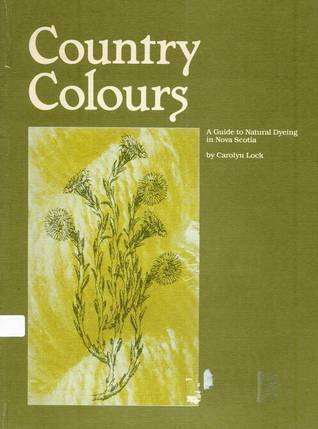I can't believe it's been 6 months since my last book review. Back to the reference library we go. Truth be told, I read this one a while ago and wasn't sure I would write a review, but I figure it will help to show the diversity in our little library collection.
This time I'm branching out into yet another area, a seemingly random review of Country Colours: A Guide to Natural Dyeing in Nova Scotia by Carolyn Lock. This is one of our vintage Nova Scotia Museum publications, and it's actually older than me. I know, hard to believe, but true.
The book is broken down into the following sections: introduction, historic perspective, directions for natural dyeing of wool, collecting dye plants, special dyestuffs, materials, equipment & safety, problems, and an annotated bibliography for more reading.
I can't say that this was the most riveting book I've ever read, or that I am planning on running out and tracking down plants to test out my dyeing skills. But as I was reading, I kept thinking about what wonderful programming opportunities exist for museums. I could picture foragers young and old traipsing around the museum grounds and getting dirty as they try their hands at natural dyeing.
I really enjoyed the historic perspective as a way to start things off. I think this is partially because of our Made in Nova Scotia database work, and partially because I like that sort of thing. It was neat to read about dyers in Nova Scotia; where they came from, what kind of work they did, and where they were located. I'll definitely be adding them to our database, although I doubt we will ever be able to tie them to artifacts in museum collections. It seems like a rather invisible sort of job.
The drawings in the book are pretty great. It's unfortunate that they aren't in colour, but the detail is still so good that you shouldn't have any trouble recognizing plants. Lock outlines which parts of the plant are useful and how to do the work in a safe way. Depending on what you're doing and how much you are making, you'll be dealing with a very hot and heavy mix.
One of the other fun things in the book is a troubleshooting section. They use the term "problems", but still, same difference. If I were to embark on a dyeing adventure I'm sure I would use this a lot. Did the colour come out unevenly? Did it bleed? Does it look dull? This is a great help if you're new to dyeing and want to test things out before rolling out a program. You'll easily be able to see how to improve the process based on what the book says about your results. And there are some blank pages at the back for your notes, making it easy to document any recipe or other adjustments you make.
It's true that this is an older book, and that a lot of changes have taken place since its publication, both in terms of environment (dare I say climate?) change and industrial development. So some of the author's recommendations on where to find plants may not be as accurate now as they were 30 years ago. But most of us Bluenosers will be able to find at least some of the plants from this list, or know a forager or two who could help us out.
So there you go. You too can try your hand at dyeing. Be sure to let me know if you try this at your museum. I'd love to see pictures of the process and hear what your visitors and community thinks of it all.


No comments:
Post a Comment